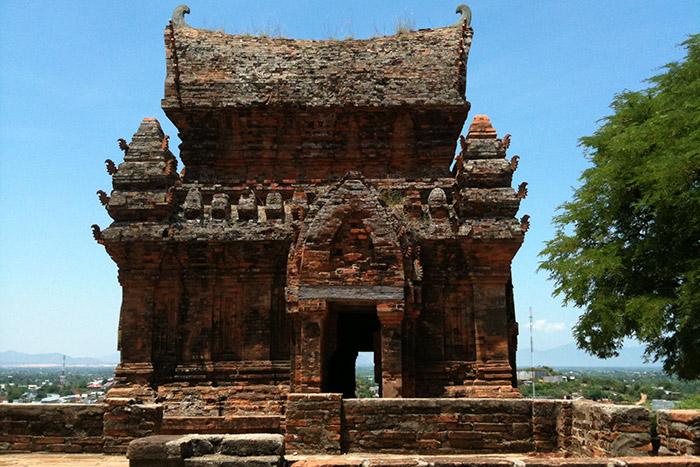Po Klong Garai Temple, Vietnam.

Address
Po Klong Garai Temple, BácÁi, ĐôVinh, Phan Rang-ThápChàm, NinhThuận, Vietnam.
Diety
Mukhalinga (Shiva)
Introduction
Po KlongGarai Temple is a Cham religious complex located in the Cham principality of Panduranga, in what is now Phan Rang in southern Vietnam. It was built in honor of the legendary king Po KlaungGarai, who ruled Panduranga from 1151 to 1205, by the historic King Jaya Sinhavarman III. This Po KlongGarai Cham temple complex, classified as a special national site, is rightly considered as the most beautiful and grandiose among the Cham remains left on the coast of the central region of Vietnam which was once the lost kingdom of Champa. The Po KlongGarai Cham Temple is located on Trau Hill, on the very site of the Panduranga historic city, 7km west of the centre of Phan Rang City, NinhThuan Province, between two well-known seaside resorts in Vietnam: NhaTrang in the north and Mui Ne in the south. This Cham architectural marvel, representing an important religious site, is a complex of 3 towers: Po KlongGarai which is the main tower, Lua tower and Cong tower. Now these privilege site is ruins condition. Remains of ancient brick temple.The primary religious image in the temple is a mukhalinga of the 16th or 17th century. A mukhalinga is a linga with a human face. In general, the linga is the emblem of the Hindu god Siva, but the Cham say that this one is a statue of King Po KlaungGarai. The temple is still the site of Cham religious festivals.
Puranic Significance
According to legend, Po KlongGarai tower were built by King Jaya Simhavarman III, who ruled the Champa Kingdom from 1285 to 1307. He wanted to honour King Po KlongGarai who was a young herdsman before becoming the king of the Cham of the first Panduranga-Champane dynasty, reigning from 1167 to 1205. Po KlongGarai or Jaya Indravarman IV was venerated by the Cham people because he settled the matter peacefully with the Khmers who seemed to want to invade his kingdom. It is the French archaeologist Henri Parmentier who first in August 1901 undertook excavations on the site of Po KlongGarai. As chief of Archaeological Service of the French School of the Far East (EFEO) and essential member of this institution from its creation in 1898, Henri Parmentier was mandated by the EFEO to study and record the Cham monuments in Vietnam, especially in Annam the central region of the country, cradle of cham culture. His work on Po KlongGarai brought a more precise knowledge of these two dominant cultures in Indochina at that time, the culture of the Champa kingdom and the culture of the Khmer Empire. This central part of the Po KlongGarai site, known as Thap Mam – BinhDinh, is rich in Cham archaeological remains. Moreover, a gallery is dedicated to him at the Museum of Cham Sculpture in Da Nang where exposes many significant Cham relics of Hindu temples built from the 11th to the 15th century when the centre of power of the Champa kingdom was based.
Special Features
The Po KlongGarai temple belongs to what is known as the Thap Mam style. The style of Thap Mam, between the 11th and 13th centuries, is considered more decorative and distinguished by simplified parts but with a very neat ornamentation that reflects the virtuosity of the sculptors of the time. At the Museum of Cham Sculpture in Da Nang you can admire the Thap Mam style with the Gajasimha sandstone or elephant-lion statue. After climbing a series of brick steps, you reach the first of the 3 towers of the complex, Lua Tower (Tower of Fire) which is located on top of a hill. This tower, all brick, is 9 metres high and has 4 entrances. This small tower was an entrance tower and its use was reserved to accommodate offerings for the traditional rites of the past. The Cong Tower (Gate Tower) also has 4 entrances oriented towards the 4 cardinal points. This elongated tower is distinguished by its saddle-shaped roof, which harmoniously illustrates the Thap Mam style of Cham Art. This tower is known to be dedicated to the god of Flames, Thang Chuh Yang Pui. As for the main tower, beautifully preserved, it is characterised by the purity of its lines and the austerity of its decorations. Above the front door is a sculpture of the god Shiva, considered to be one of the masterpieces of the Thap Mam style and listed in the historical-architectural remains of the Cham sculptural art. The main tower houses the stature of King Po KlongGarai (1151-1205) with the symbol Mukha-Linga.
Festivals
Traditional Kate Celebration at Po KlongGarai Temple.
Century/Period/Age
1000-2000 Years old
Nearest Bus Station
Vietnam
Nearest Railway Station
Thap Cham
Nearest Airport
Cam Ranh




